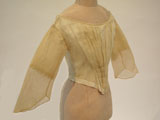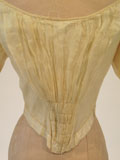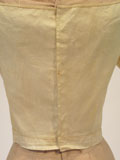The bodice, likely from the late 1840s, is made with a base of white polished (glazed) handkerchief linen with an overlay of off-white cotton organdy. It is completely sewn by hand.
Overview
 |
| Figure 1: Original Garment |
This bodice is most likely from the late 1840s. The bodice can be dated to this decade because of the long pointed waistline, the boat neckline, the dropped shoulder seam, and the shape of the sleeves. When dating the bodice the over layer on the front of the bodice helps to determine that it is from the later half of the decade. Referencing the center front, Norah Waugh on page 140 in The Cut of Women's Clothes: 1600-1930, states that “from the late 1840s…the fullness [at center front is] a piece of material separate from the fitted body (140)”. Also to help date it in the later half of the 1840s is the fact that the sleeves are cut on the cross grain and widen at the elbow. This is characteristic of bodices after 1844 (Waugh 140). Jean Hunnisett, on page 70 in Period Costume for Stage and Screen: Patterns for Women's Dresses 1800-1909, also mentions that “towards the end of the decade, full-length sleeves became shorter and began to flare out into a small bell or trumpet sleeves.”
The bodice is made from white polished (glazed) handkerchief linen and off-white cotton organdy. It most likely would have had a bertha collar worn with it. The sleeves have a hand crocheted lace border on the under layer.
Construction
This bodice is completely hand sewn. The fitted layer of polished (or glazed) handkerchief linen has a center front seam while the over layer of organdy is hand gathered at the center front. The inner layer is cut on the bias and the outer layer is straight of grain at center front. The two fabrics are flat-lined together for the two center back pieces and at the shoulder seams and side seams of the front pieces. Center back is on straight grain. The shoulder seam is set towards the back 3/4". Two 10" darts on either side of center front of the under layer create a small amount of bust shape. There are 7 1/2" bones at the side seams, 8 5/8" ones on the darts, and one 9 inch bone at center front. All seam allowances are hand overcast. The neckline, hem, shoulder seam, and armsceye are corded with 1/16" cord covered in organdy. The neckline is also bound in organdy bias. The waist is bound with 1" folded linen on the straight of grain with a seam at center front. The bodice closes with thirteen hook and eyes down the center back. The center back is self-faced. There are two separate sleeves in each armseye. The hem of the inner sleeve is the selvedge edge. The outer sleeve is made of organdy and has a shaped hem that is finished with a hand rolled hem. The seam in the sleeve is rotated towards the forearm. Both sleeves are "stitched in the ditch" of the cording around the armseye and the seam allowances are unfinished.
 |
 |
 |
| Figure 2: Original Shoulder Seam | Figure 3: Inside Front of Original Garment | Figure 4: Seam Placement in Original Sleeve |
The center front measures 13 1/4" from neckline to hem and the center back measures 11 1/4". The neckline is 32 1/2" around and the waistband is 27" around. The inner sleeve is 6 3/8" long with the 1/2" lace on the hem, while the outer organdy sleeve is 10 7/8" long. The gathering on the outer layer at center front is 1 3/4" wide at the waist and 12 3/4" wide at the neckline.
Reproduction and Pattern
When reproducing this garment I finished all of the seams with a two-stitch-and-zig technique. I moved the shoulder seam slightly forward and raised the neckline to allow for a modern body. Instead of using the selvedge edge for the hem of the inner sleeves, I did a proper hem and then machine stitched the lace onto the hems. I also changed the shape at the hem to be more of a point and added a seam in the waistband to create that point; a dart in the waistband created that shape in the original.
The pattern has been drawn on standard pattern paper. The bodice consists of three pieces: the front foundation, the front outer layer, and the back which has identical layers. The sleeve consists of two piecies, one for the inner sleeve and one for the outer. The placement of trim is indicated on the pattern as is the location of gathering stitches to control the fullness in the front of the bodice that provides its shape.
© Claire Fleming, 2011





